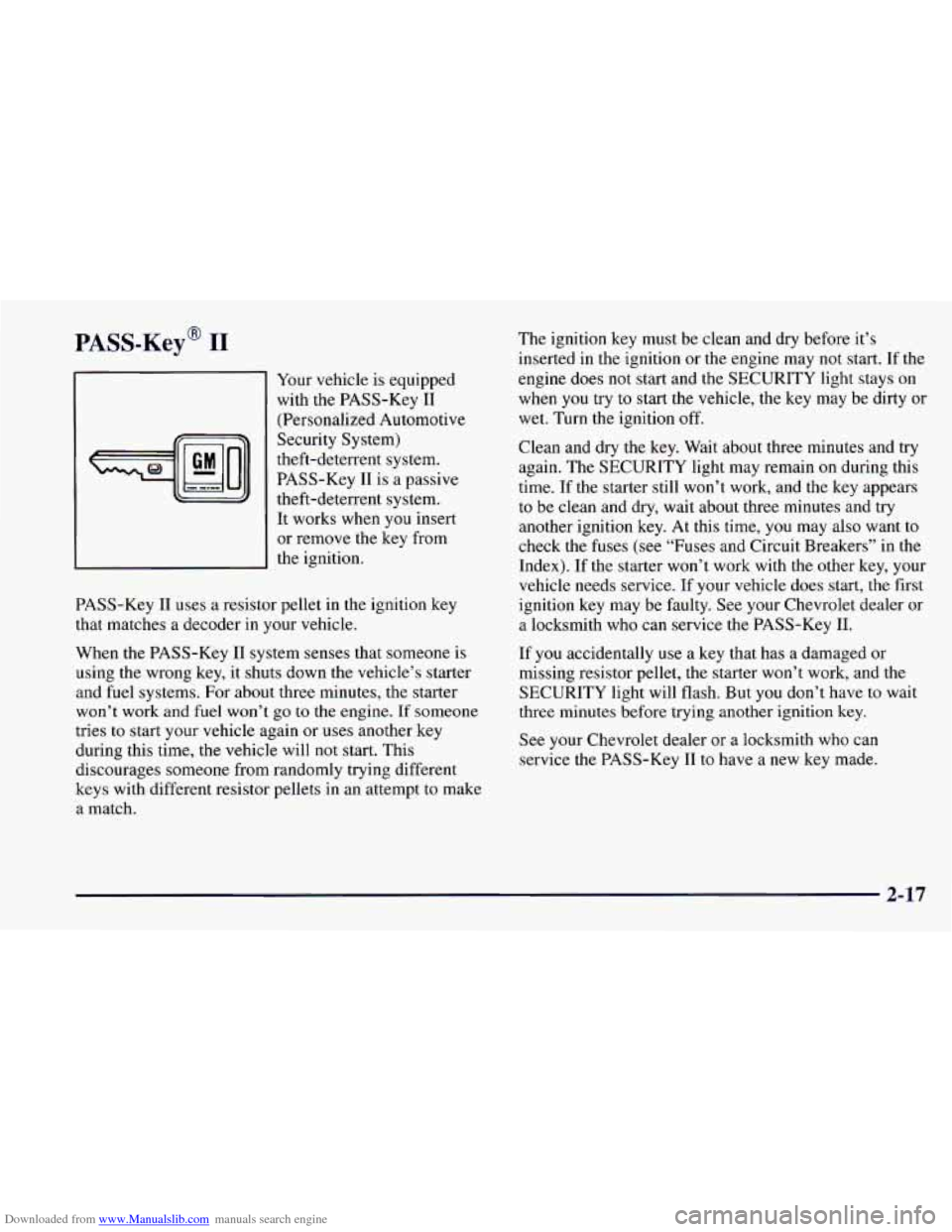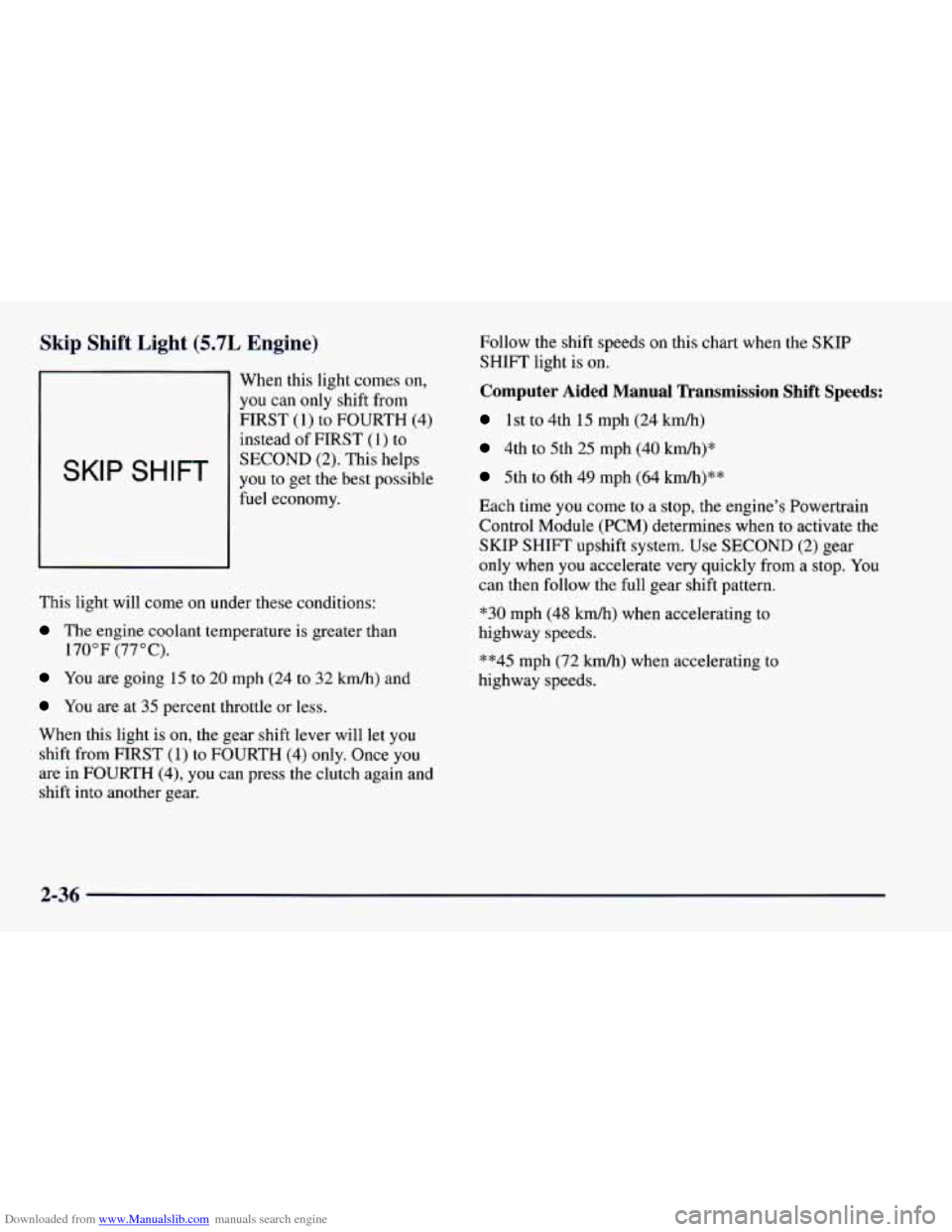Page 7 of 404
Downloaded from www.Manualslib.com manuals search engine and we are pledged to
make ownership of your
Chevrolet an enjoyable
and rewarding experience.
I
I
The 1957 Chevy started u romance with the American
public
-- and was powered by an available fuel-injected V8.
I I I I I I I I I I I I
I
I
I
I
I I I I
I
I
60's automotive excitement
included Chevrolet landmarks
like the Corvette Sting
Ray,
the sporty Camaro, and Your new Clzevrolet continues u tradition of quality and value.
powerplants like the legendary
327 V8.
V
Page 10 of 404
Downloaded from www.Manualslib.com manuals search engine Vehicle Symbols
These are some of the symbols you may find on your vehicle.
For example,
these symbols
are used on an
original battery:
POSSIBLE A
CAUTION
INJURY
PROTECT EYES BY
SHIELDING
CAUSTIC
BURNS AVOID
SPARKS
OR
FLAMES
SPARK
OR ,\I/,
COULD FLAME
EXPLODE BAllERY
These symbols
are important
for you and
your passengers
whenever your
vehicle
is
driven:
DOOR LOCK
UNLOCK
FASTEN SEAT
BELTS
These symbols have to
do with
your
lamps:
SIGNALS e a
TURN
FOG LAMPS
$0
These symbols
are
on some of
your controls:
WINDSHIELD
WIPER
WINDSHIELD DEFROSTER
WINDOW
DEFOGGER
These symbols
are used
on
warning and
indicator lights:
ENGINE t
COOLANT
TEMP
-
CHARGING 1-1
BAllERY
SYSTEM
BRAKE
(@)
COOLANT a
ENGINE OIL w,
PRESSURE
ANTI-LOCK
(a)
BRAKES
Here are some other symbols
you may
see:
FUSE
t
LIGHTER m
HORN k3
SPEAKER
Er
FUEL B
...
Page 67 of 404

Downloaded from www.Manualslib.com manuals search engine PASS-Key@ I1
Your vehicle is equipped
with the PASS-Key I1
(Personalized Automotive
Security System)
theft-deterrent system.
PASS-Key
I1 is a passive
theft-deterrent system. It works when you insert
or remove the key from
the ignition.
PASS-Key 11 uses a resistor pellet in the ignition key
that matches a decoder in your vehicle.
When the PASS-Key I1 system senses that someone is
using the wrong key, it shuts down the vehicle’s starter
and fuel systems. For about three minutes, the starter
won’t work and fuel won’t
go to the engine. If someone
tries
to start your vehicle again or uses another key
during this time, the vehicle will not start. This
discourages someone from randomly trying different
keys with different resistor pellets in an attempt to make
a match. The
ignition key must be clean and dry before it’s
inserted in the ignition
or the engine may not start. If the
engine does not start and the SECURITY light stays on
when
you try to start the vehicle, the key may be dirty or
wet. Turn the ignition
off.
Clean and dry the key. Wait about three minutes and try
again. The SECURITY light may remain
on during this
time.
If the starter still won’t work, and the key appears
to be clean and dry, wait about three minutes and try
another ignition key. At this time,
you may also want to
check the fuses
(see “Fuses and Circuit Breakers” in the
Index). If the starter won’t work with the other key, your
vehicle needs service. If your vehicle does start, the first
ignition key may be faulty. See your Chevrolet dealer or
a locksmith who can service the PASS-Key 11.
If
you accidentally use a key that has a damaged or
missing resistor pellet, the starter won’t work, and
the
SECURITY light will flash. But you don’t have to wait
three minutes before trying another ignition key.
See your Chevrolet dealer or a locksmith who can
service the PASS-Key
I1 to have a new key made.
2-17
Page 77 of 404
Downloaded from www.Manualslib.com manuals search engine NOTICE:
Your engine is designed to work with the
electronics in your vehicle.
If you add electrical
parts
or accessories, you could change the way
the engine operates. Before adding electrical
equipment, check with your dealer.
If you don’t,
your engine might not perform properly.
If you ever have to have your vehicle towed, see
the part of this manual that tells how to
do it
without damaging your vehicle. See “Towing
Your Vehicle” in the Index.
Engine Coolant Heater (If Equipped)
In very cold weather, 0°F (- 18OC) or colder, the engine
coolant heater can help. You’ll get easier starting and
better fuel economy during engine warm-up. Usually,
the coolant heater should be plugged in a minimum of
four hours prior
to starting your vehicle.
Page 81 of 404

Downloaded from www.Manualslib.com manuals search engine AUTOMATIC OVERDRIVE (@):
This position is for normal driving. If you need more
power for passing, and you’re:
- Going less than about 35 mph (56 km/h), push your
- Going about 35 mph (56 km/h) or more, push the
You’ll shift down
to the next gear and have more power.
DRIVE (D): This position is also used for normal
driving, however, it offers more power and lower fuel
economy than AUTOMATIC OVERDRIVE
(a).
Here are some times you might choose DRIVE (D)
instead of AUTOMATIC OVERDRIVE (a):
accelerator pedal about halfway down.
accelerator all the way down.
- When driving on hilly, winding roads.
- When towing a trailer, so there is less shifting
between gears.
- When going down a steep hill.
SECOND (2): This position gives you more power but
lower fuel economy.
You can use SECOND (2) on hills.
It can help control your speed as
you go down steep
mountain roads, but then you would also want
to use
your brakes off and on.
NOTICE:
Don’t drive in SECOND (2) for more than 25 miles
(40 km), or at speeds over 55 mph (88 km/h),
or you can damage your transmission. Use
AUTOMATIC OVERDRIVE (@) or DRIVE (D)
as much as possible.
Don’t shift into SECOND
(2) unless you are going
slower than
65 mph (105 kd), or you can
damage your engine.
FIRST
(1): This position gives you even more power
(but lower fuel economy) than
SECOND (2). You
can use it on very steep hills, or in deep snow or mud.
If the selector lever
is put in first gear, the transmission
won’t shift into FIRST
(1) until the vehicle is going
slowly enough.
2-31
Page 85 of 404
Downloaded from www.Manualslib.com manuals search engine f’ iff lpeeds
A CAUTION:
If you skip more than one gear when you
downshift, you could lose control of your vehicle.
And you could injure yourself or others. Don’t
shift from SIXTH
(6) to THIRD (3), or FIFTH (5)
to SECOND (2) or FOURTH (4) to FIRST (1).
MANUAL TRANSMISSION RECOMMENDED SHIFT SPEEDS, IN MPH (kmlh) I I
Engine Acceleration Shift Speed
It02 I 2to3 I 3to4 I 4105 I 5to6
This chart shows when to shift to the next higher gear
for best fuel economy.
If your speed drops below 20 mph (30 km/h), or if the
engine is not running smoothly, you should downshift
to
the next lower gear. You may have to downshift two or
more gears to keep the engine running smoothly
or for
good performance.
NOTICE:
If you skip more than one gear when you
downshift, or if you race the engine when you
downshift, you can damage
the clutch
or transmission.
2-35
Page 86 of 404

Downloaded from www.Manualslib.com manuals search engine Skip Shift Light (5.7L Engine)
When this light comes on,
you can only shift from
FIRST (1) to FOURTH (4)
instead
of FIRST (1) to
SECOND (2). This helps
you to get the best possible
fuel economy.
This light will come on under these conditions:
The engine coolant temperature is greater than
170°F (77°C).
You are going 15 to 20 mph (24 to 32 km/h) and
You are at 35 percent throttle or less.
When this light is on, the gear shift lever
will rer you
shift from FIRST (1) to FOURTH (4) only. Once you
are in
FOURTH (4), you can press the clutch again and
shift into another gear. Follow
the shift speeds
on this chart when the SKIP
SHIFT light is on.
Computer Aided Manual Transmission Shift Speeds:
1st to 4th 15 mph (24 km/h)
4th to 5th 25 mph (40 km/h)*
5th to 6th 49 mph (64 km/h)**
Each time you come to a stop, the engine's Powertrain
Control Module (PCM) determines when to activate the
SKIP SHIFT upshift system. Use
SECOND (2) gear
only when you accelerate very quickly from a stop.
You
can then follow the full gear shift pattern.
"30 mph (48 km/h) when accelerating to
highway speeds.
**45 mph (72 km/h) when accelerating to
highway speeds.
2-36
Page 126 of 404
Downloaded from www.Manualslib.com manuals search engine Instrument Panel Cluster
Your instrument cluster is designed to let you know at a glance how your vehicle is running. You’ll know how fast
you’re going, your engine’s rpms, about how much fuel you have left and many other things you’ll need
to know to
drive safely and economically.
2-76